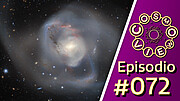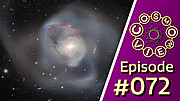Hubble image of the galaxy cluster Abell 3827
Hubble image of galaxy cluster Abell 3827 showing dark matter distribution
# # # # # # # # # # # # # # # # # # # # # # # # # # # # # # # # # # # # # # # # # # # #
Videos

Hubble view of the galaxy cluster Abell 3827
Dark matter may not be completely dark after all
For the first time dark matter may have
been observed interacting with other dark matter in a way other than
through the force of gravity. Observations of colliding galaxies made
with ESO’s Very Large Telescope and the NASA/ESA Hubble Space Telescope
have picked up the first intriguing hints about the nature of this
mysterious component of the Universe.
Using the
MUSE instrument on ESO’s
VLT in Chile, along with images from
Hubble in
orbit, a team of astronomers studied the simultaneous collision of four
galaxies in the galaxy cluster Abell 3827. The team could trace out
where the mass lies within the system and compare the distribution of
the dark matter with the positions of the luminous galaxies.
Although dark matter cannot be seen, the team could deduce its location using a technique called
gravitational lensing.
The collision happened to take place directly in front of a much more
distant, unrelated source. The mass of dark matter around the colliding
galaxies severely distorted spacetime, deviating the path of light rays
coming from the distant background galaxy — and distorting its image
into characteristic arc shapes.
Our current understanding is that all galaxies exist inside clumps of
dark matter. Without the constraining effect of dark matter’s gravity,
galaxies like the Milky Way would fling themselves apart as they rotate.
In order to prevent this, 85 percent of the Universe’s mass [1] must exist as dark matter, and yet its true nature remains a mystery.
In this study, the researchers observed the four colliding galaxies
and found that one dark matter clump appeared to be lagging behind the
galaxy it surrounds. The dark matter is currently 5000 light-years (50
000 million million kilometres) behind the galaxy — it would take NASA’s
Voyager spacecraft 90 million years to travel that far.
A lag between dark matter and its associated galaxy is predicted
during collisions if dark matter interacts with itself, even very
slightly, through forces other than gravity [2]. Dark matter has never before been observed interacting in any way other than through the force of gravity.
Lead author Richard Massey at Durham University, explains: “We
used to think that dark matter just sits around, minding its own
business, except for its gravitational pull. But if dark matter were
being slowed down during this collision, it could be the first evidence
for rich physics in the dark sector — the hidden Universe all around us.”
The researchers note that more investigation will be needed into
other effects that could also produce a lag. Similar observations of
more galaxies, and computer simulations of galaxy collisions will need
to be made.
Team member Liliya Williams of the University of Minnesota adds: “We
know that dark matter exists because of the way that it interacts
gravitationally, helping to shape the Universe, but we still know
embarrassingly little about what dark matter actually is. Our
observation suggests that dark matter might interact with forces other
than gravity, meaning we could rule out some key theories about what
dark matter might be.”
This result follows on from a
recent result from the team which observed 72 collisions between galaxy clusters
[3]
and found that dark matter interacts very little with itself. The new
work however concerns the motion of individual galaxies, rather than
clusters of galaxies. Researchers say that the collision between these
galaxies could have lasted longer than the collisions observed in the
previous study — allowing the effects of even a tiny frictional force to
build up over time and create a measurable lag
[4].
Taken together, the two results bracket the behaviour of dark matter
for the first time. Dark matter interacts more than this, but less than
that. Massey added: “We are finally homing in on dark matter from above and below — squeezing our knowledge from two directions.”
Notes
[1] Astronomers have found that the total mass/energy content of the
Universe is split in the proportions 68% dark energy, 27% dark matter
and 5% “normal” matter. So the 85% figure relates to the fraction of
“matter” that is dark.
[2] Computer simulations show that the
extra friction from the collision would make the dark matter slow down.
The nature of that interaction is unknown; it could be caused by
well-known effects or some exotic unknown force. All that can be said at
this point is that it is not gravity.
All four galaxies might have been separated from their dark matter.
But we happen to have a very good measurement from only one galaxy,
because it is by chance aligned so well with the background,
gravitationally lensed object. With the other three galaxies, the lensed
images are further away, so the constraints on the location of their
dark matter too loose to draw statistically significant conclusions.
[3] Galaxy clusters contain up to a thousand individual galaxies.
[4] The main uncertainty in the result
is the timespan for the collision: the friction that slowed the dark
matter could have been a very weak force acting over about a billion
years, or a relatively stronger force acting for “only” 100 million
years.
More Information
This research was presented in a paper entitled “The behaviour of
dark matter associated with 4 bright cluster galaxies located in the 10
kpc core of Abell 3827” to appear in the journal Monthly Notices of the Royal Astronomical Society on 15 April 2015.
The team is composed of R. Massey (Institute for Computational
Cosmology, Durham University, Durham, UK), L. Williams (School of
Physics & Astronomy, University of Minnesota, Minneapolis,
Minnesota, USA), R. Smit (Institute for Computational Cosmology, UK), M.
Swinbank (Institute for Computational Cosmology, UK), T. D. Kitching
(Mullard Space Science Laboratory, University College London, Dorking,
Surrey, UK), D. Harvey (Ecole Polytechnique Fédérale de Lausanne,
Observatoire de Sauverny, Versoix, Switzerland), H. Israel (Institute
for Computational Cosmology, UK), M. Jauzac (Institute for Computational
Cosmology, UK; Astrophysics and Cosmology Research Unit, School of
Mathematical Sciences, University of KwaZulu-Natal, Durban, South
Africa), D. Clowe (Department of Physics and Astronomy, Ohio University,
Athens, Ohio, USA), A. Edge (Department of Physics, Durham University,
Durham, UK), M. Hilton (Astrophysics and Cosmology Research Unit, South
Africa), E. Jullo (Laboratoire d’Astrophysique de Marseille, Université
d’Aix-Marseille, Marseille, France), A. Leonard (University College
London, London, UK), J. Liesenborgs (Hasselt University, Diepenbeek,
Belgium), J. Merten (Jet Propulsion Laboratory, California Institute of
Technology, Pasadena, California, USA; California Institute of
Technology, Pasadena, California, USA), I. Mohammed (Physik-Institüt,
University of Zürich, Zürich, Switzerland), D. Nagai (Department of
Physics, Yale University, New Haven, Connecticut, USA), J. Richard
(Observatoire de Lyon, Université Lyon, Saint Genis Laval, France), A.
Robertson (Institute for Computational Cosmology, UK), P. Saha
(Physik-Institüt, Switzerland), R. Santana (Department of Physics and
Astronomy, Ohio University, Athens, Ohio, USA), J. Stott (Department of
Physics, Durham, UK) and E. Tittley (Royal Observatory, Edinburgh, UK).
ESO is the foremost intergovernmental astronomy organisation in
Europe and the world’s most productive ground-based astronomical
observatory by far. It is supported by 16 countries: Austria, Belgium,
Brazil, the Czech Republic, Denmark, France, Finland, Germany, Italy,
the Netherlands, Poland, Portugal, Spain, Sweden, Switzerland and the
United Kingdom, along with the host state of Chile. ESO carries out an
ambitious programme focused on the design, construction and operation of
powerful ground-based observing facilities enabling astronomers to make
important scientific discoveries. ESO also plays a leading role in
promoting and organising cooperation in astronomical research. ESO
operates three unique world-class observing sites in Chile: La Silla,
Paranal and Chajnantor. At Paranal, ESO operates the Very Large
Telescope, the world’s most advanced visible-light astronomical
observatory and two survey telescopes. VISTA works in the infrared and
is the world’s largest survey telescope and the VLT Survey Telescope is
the largest telescope designed to exclusively survey the skies in
visible light. ESO is a major partner in ALMA, the largest astronomical
project in existence. And on Cerro Armazones, close to Paranal, ESO is
building the 39-metre European Extremely Large Telescope, the E-ELT,
which will become “the world’s biggest eye on the sky”.
Links
Contacts:
Richard Massey
Institute for Computational Cosmology
Durham University, United Kingdom
Tel: +44 (0) 7740 648080
Email: r.j.massey@durham.ac.uk
Richard Hook
ESO, Public Information Officer
Garching bei München, Germany
Tel: +49 89 3200 6655
Cell: +49 151 1537 3591
Email: rhook@eso.org























